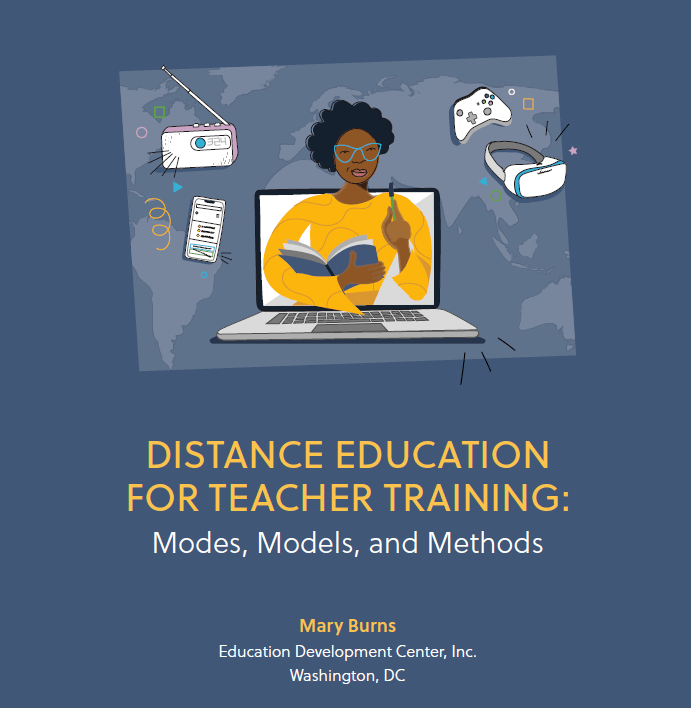A New Guide Examines The Future Of Distance Education
So much to read on distance education, and so little time! This article outlines what EDC's new publication, Distance Education for Teacher Training: Modes, Models and Methods, offers to eLearning professionals and why you might want to give it a look.

What This Guide On The Future Of Distance Education Offers
It Summarizes The Evidence Base
This guide provides an overview of common technologies used for distance education—audio, video and TV, multimedia (including Virtual Reality, Mixed Reality and Augmented Reality), online and mobile technologies, with both text and charts summarizing the research. It incorporates lessons learned over the last decade, particularly from the global shift to online learning during the COVID-19 global pandemic. Drawing on data from 188 countries and nearly 700 publications, this guide offers the most detailed, global, and up-to-date information on the most valuable inputs for eLearning. More on that in a moment.
It Lists Helpful eLearning Resources, Tools, And eLearning Professionals
Within this guide, you will find links to various standards (for online course design, content development, online instruction, and online coaching), online tools like course design checklists, Instructional Design frameworks, scenario builders, protocols, evaluation tools, quality assurance checklists, quick guides, and lists of dos and don’ts. For those that design, or are getting started with designing, eLearning courses, chapters 11, 12, and 17 may be of most use. Here you’ll find lists of (mostly free) digital tools (from Twine and H5P to Supermeme and Vyond).
In addition to tools and resources, the guide links to valuable eLearning organizations and companies, such as Articulate360, the International Society of Technology in Education, open universities across the globe, and eLearning Industry, of course! It links to clearinghouses of low-cost and no-cost technology tools, such as OER Commons, and simple online platforms-cum-tools such as Choiceboards and HyperDocs. And it links to the work of some of my favorite eLearning professionals, including Cathy Moore, Jodi Sansone (who develops gorgeous and rich Storyline designs), Nicole Zumpano, and Torrey Trust (whose terrific resources on ChatGPT are valuable no matter your profession), as well as to Arjana Blazic’s delightful Choiceboards, and Denise-Henry Orndorff terrific periodic table of Chrome extensions (yes, you will have to read the guide to find these).
It Contains Advice For Creating High-Quality eLearning Courses
While Section I of the guide examines the research on various technologies in detail, Section II is the "how to" section. Here you’ll find practical advice on instruction, Instructional Design, content development, preparing online instructors and learners, supporting online learners, assessment, evaluating eLearning, assuring quality, and selecting appropriate technologies—and the standards and best practices associated with each to ensure that online learning truly results in meaningful learning and measurable outcomes. And for those of us who’d rather read 280 characters than 280 pages, the guide is organized into chapters, so you can directly read about your areas of interest alone!
It Contains Multiple Models Of Distance Education Projects And Activities
What better way to learn about eLearning than from our university, school system, private and public sector, and donor-funded online, mobile, video-based and multimedia-based projects, initiatives, and programs? There’s so much good stuff happening across the globe: audio instruction in sub-Saharan Africa, digital learning games and Extended Reality for preservice teachers in the US, Augmented Reality in Portugal, mobile learning in the Caribbean, online courses for refugees in Germany, and virtual coaching in Indonesia. These are just some of the models and examples discussed in this guide.
It Connects The Past And Present Of Online Learning
While forward looking, this guide connects us to the history of distance learning so we can understand its potential in full. The "Foreword", for example, uses the example of my mother’s correspondence course in the 1930s as she studied for a diploma in Pittman shorthand. This diploma was a gateway to a middle-class life for her. Distance education has certainly evolved from 1939 but its benefits have remained constant over time.
Conclusion
Distance technologies like online learning can eliminate one of the biggest factors influencing the quality of education—a learner’s geographic location. Without distance education and its future forms—such as online, multimedia, and mobile learning—access to education would be impossible in many parts of the globe. That may be the most important message of all in this guide.
Find Distance Education for Teacher Training: Modes, Models and Methods in PDF, EPUB, and separate chapters.
Image Credits:
- The image within the body of the article was supplied by the author.









